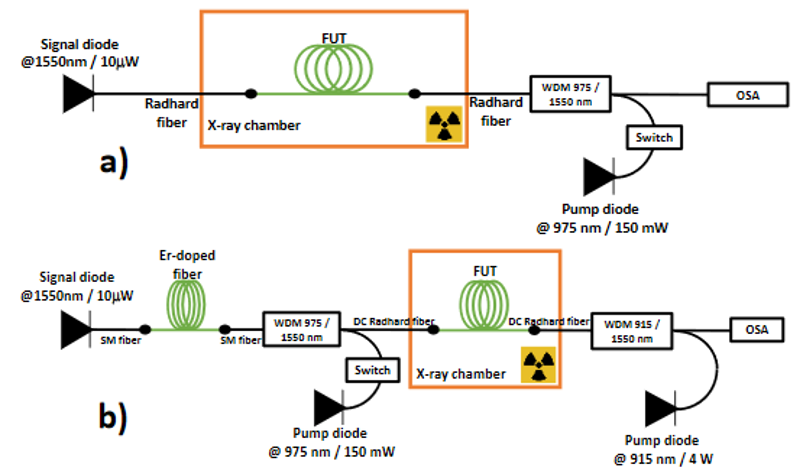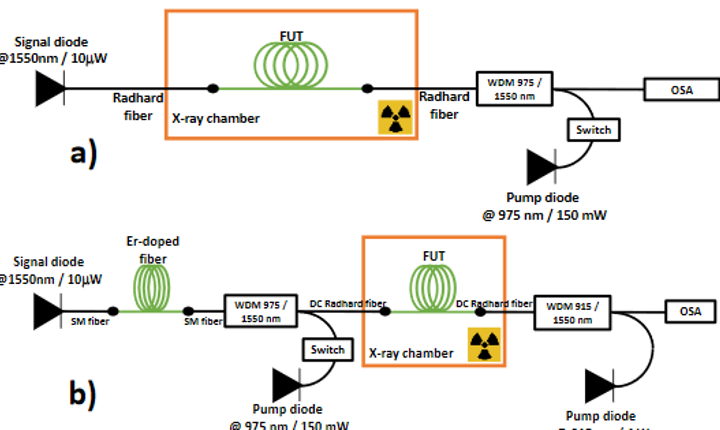Article: Optimization of the Radiation Response of Backup Optical Fiber Amplifiers for Space Missions
In January 2022, an article by the Laboratoire Hubert Curien’s MOPERE team has been published in IEEE Transactions on Nuclear Science. The work has been produced within the “LabH6” Joint Lab framework, uniting the University of Saint-Etienne, the CNRS and iXblue.
Optical fiber-based amplifiers embedded in spacecrafts are susceptible to degradation due to the harsh environment of space, and specifically due to radiation. However, we have observed a greater degradation of the backup device, compared with that of the main device in operation. The purpose of this paper was to investigate how the backup device could be more impacted by its «OFF» state and how the pump, used when amplifiers are running, could allow the backup device to be less degraded if we inject it into the fiber from time to time.
Abstract
We investigated the X-ray radiation impact on the performances of “backup” Erbium Doped Fiber Amplifiers (EDFAs) and Erbium-Ytterbium Doped Fiber Amplifier (EYDFA). These devices, once integrated on spacecrafts, are exposed to the space radiation constraints, unpowered in the “OFF” mode, up to their hypothetic activation during the mission. This atypical profile of use must be considered as it could lead to a higher radiation vulnerability. To carry this study, active optical fibers differing in terms of radiation hardness, have been exposed to steady-state X-rays under different profiles of amplifier use: the gain degradation is measured by varying the pumping conditions, that drive the photobleaching phenomenon allowing to reduce the losses in the fiber, during the radiation exposure: “ON” (100% ON), “OFF” (0% ON), and “OFF-ON-OFF” with powering 2% or 10% of the time. Our results show that the impact of the pump and its related photobleaching efficiency depend on the selected active fiber to build the amplifier. An important result is that the “backup” EDFA designed with radiation-hardened Ce-doped fiber does not suffer from an extra-degradation due to the “OFF” mode, contrary to the one designed with a non-rad-hard fiber. For this latter one, it is indeed possible to reduce the extra-gain degradation by powering the amplifier for short time periods during the “OFF” state, otherwise the EDFA recovers this extra-gain degradation in a few hours after turning “ON” in our test conditions. For the tested radiation-tolerant EYDFA, an enhanced vulnerability is observed for the “OFF” amplifier, that can be reduced too by briefly powering the amplifier. The origins of these effects are discussed basing on the properties of point defects related to the aluminosilicate (EDFA) and phosphosilicate (EYDFA) glasses of the fiber.»

lllustration above:
Amplifier Radiation-induced gain degradation measurement setup for a) EDFA and b) the EYDFA.

a) EDFA1 gain degradation as function of the time and dose, at the three different pumping conditions; b) Pumping conditions for the three EDFA1 tests.
Illustration above:
a) EDFA1 gain degradation as function of the time and dose, at the three different pumping conditions; b) Pumping conditions for the three EDFA1 tests.
Read the full article here.

